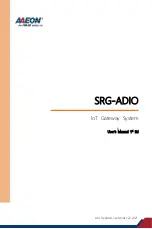
Com.X Administrator Guide
Page 119
. matches one or more digits, e.g. 0. would match a 0 followed by one or more digits
! provides legacy overlap dialing support and matches as soon as it can
unambiguously, without waiting for the dialing to complete, allowing subsequent digits
to be transferred directly to the trunk (only supported on PRI channels).
[ ] allows a collection of digits to be matched, e.g. [7-9] would match 7, 8 and 9
- indicates a range of sequential numbers to match
+ in conjunction with | allows insertion of digits into the dial string, e.g. to change
0114567890 to 27114567890 use dial rule '27+0|X.' in the Dial Rules section on the
trunk from the Advanced menu
Removing Dial Patterns from a route
A Dial Pattern can be removed from a route by selecting Remove from the pattern's
context menu.
3.10.5 Adding trunks to an outbound route
Trunks can be added to a route by selecting Add from the context menu of the Trunk
Priorities section of the route. The route has to be edited first before this option
becomes available. If no existing trunks are included in the route, the context menu
can be accessed by right-clicking the Trunk Priorities header.
A list of available trunks, including analogue trunks (FXO), BRI trunks, PRI, SIP
providers and Trunk Groups will be displayed. Multiple trunks and groups can be
selected for addition by using Ctrl-Left-Click.
Once added, trunks can be prioritized by selecting a trunk and selecting Up or Down
from the trunk's context menu. Calls will be attempted on the trunks in the order that
they appear in this list.
3.10.6 Removing Trunks from a route
A Trunk can be removed from a route by selecting Remove from the trunk's context
menu.
3.10.7 Deleting outbound routes
To delete an outbound route, select Delete from the route's context menu.
3.10.8 Outbound route priority
Outbound routes can be moved up and down the overall list by right-clicking and
selecting Up or Down. An outbound number that matches a pattern in more than one
route will be routed via the highest priority route.
3.11 Inbound route configuration
Inbound routes allows incoming calls to be routed to a particular destination based on
the incoming call's DID and CID number pair. The Com.X supports a rich set of
destination types, greatly simplifying incoming call routing.
Note: The Com.X will automatically try and find extension numbers that match
incoming DIDs. E.g. if the system receives a call from a BRI link with DID 9031, and
an extension 9031 exists, no inbound route is necessary. The call will automatically
be routed to extension 9031.
©2010 –
2016
Far South Networks
















































